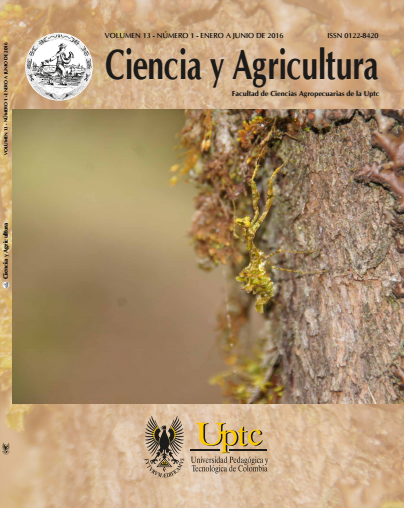Lactobacillus spp. effect evaluation in the small intestine development in broiler chickens

Abstract
The probiotic Lactobacillus spp. type, are considered promising alternatives to replace the use of antibiotics as growth promoters (APC) in poultry farms, due to their influence in the gastrointestinal tract (GIT) poseclosion development and in their microbial ecology. Thereof in this study the morphometry of the small intestine in broilers to provide with 0.5 mL/L of a commercial product based on Lactobacillus spp. were evaluated. 200 male chickens a day old, from the Cobb Avian 48 line were used, distributed under a completely randomized design, in two groups, called control and experiment. Both groups were kept in similar conditions of feeding, management and health care.
At 7, 15 and 35 days old sacrifice and necropsy was performed. Segments from duodenum, jejunum and ileum were dissected for processing with the hematoxylin-eosin (H-E) coloration technique. The villi morphometric changes in length, width and number were assessed using a trinocular microscope with digital camera Moticam®. Data were analyzed using SPSS version 19 program. Comparisons of averages were conducted through descriptive statistics and ANOVA (p < 0.05) test. Significant differences (p <0.05l were estimated in favor ofthe poseclosion development experiment group ofthe jejunum and ileum segments.
Keywords
broilers chicken, intestine development, lactobacillus, promoter, villi.
References
- (1) Pelicano E., Souza P., Souza H., Oba A., Norkus E., Kodawara,L., & Lima, T. 2003. Morfometria e ultra-estrutura da mucosa intestinal de frangos de corte alimentados com dietas contendo diferentes probióticos. Revista Portuguesa de Ciências Veterinárias, 98(547): 125-134.
- (2) García A., Ávila D., Rodríguez C. 2009. Evaluación del efecto de microorganismos eficientes en agua de bebida suministrada a pollos Ross x Ross en la granja Tunguavita. Ciencia y Agricultura, 7(1): 83-94. Colombia.
- (3) Imondi AR & Bird FH. 1966. The turnover of intestinal epithelium in the chick. Poultry Science, 45: 142-147. DOI: http://dx.doi.org/10.3382/ps.0450142.
- (4) Potten CS. 1998. Stem cells in the gastrointestinal epithelium: Numbers characteristics and death. Philos. Trans. R. Soc. Lond. Biological Sciences. 353: 821-830.
- (5) Pluske JR., Tompson MJ., Atwood CS., Bird PH., Williams IH & Hartmann PE. 1996. Maintenance of villus height and crypt depth, and enhancement of disaccharide digestion and monosaccharide absorption in piglets fed on cows’ whole milk after weaning. British Journal Nutrition, 76: 409-422. DOI: http://dx.doi.org/10.1079/BJN19960046.
- (6) Macari M., Luquetti B. 2004. Uso de aditivos (Amino Ácidos, Prebióticos y Probióticos) sobre la fisiología gastrointestinal y desempeño en pollos. Departamento de Morfología y Fisiología Animal. Universidad Estatal Paulista UNESP. Brasil 1-30.
- (7) López N. Afanador G. y Ariza CJ. 2008. Evaluación del efecto de la suplementación de levaduras sobre la morfometría de vellosidades intestinales y productos de la microflora en pollo. Revista de Medicina Veterinaria y Zootecnia, Universidad Nacional de Colombia, 55: 63-76.
- (8) Pelicano E., Souza P., Souza H., Leonel F., Zeola N., & Boiago M. 2004. Productive traits of broiler chickens fed diets containing different growth promoters. Rev. Bras. Cienc. Avic., 6(3): 177-182. DOI: http://dx.doi.org/10.1590/S1516-635X2004000300008.
- (9) Pelicano ERL., Souza PA., Souza HBA., Figueiredo DF., Biago MM., Carballo SR. & Bordon VF. 2005. Intestinal mucosa development in broiler chickens fed natural growth promoters. Brazilian Journal of Poultry Science, 7: 221-229. DOI: http://dx.doi.org/10.1590/s1516-635x2005000400005.
- (10) Velasco S., Rodríguez ML., Azueta MC., Rebole A., Ortiz LT. 2010. Los Prebióticos tipo inulina en alimentación aviar. I: Características y efectos a nivel intestinal. Revista Complutense de Ciencias Veterinarias 4(2): 87-104.
- (11) Pelicano E., Souza P., Souza H., Leonel F., Zeola N., & Boiago M. 2007. Morphometry and ultra-structure of the intestinal mucosa of broilers fed different additives. Rev. Bras. Cienc. Avic., 9(3): 173-180. DOI: http://dx.doi.org/10.1590/S1516-635X2007000300006.
- (12) Santos EC, Teixeira AS, Freitas RTF, Dias ES, Rodrigues PB, Murgas LDS, Oliveira RFM, Santos EC, & Gachett NAB. 2004. Uso de promotores de crescimento sobre o desempenho e morfometria intestinal de frangos de corte na fase inicial. Anais da 41a Reunião Anual da Sociedade Brasileira de Zootecnia; Campo Grande, MS. Brasil.
- (13) Rebolé A., Ortiz LT., Rodríguez M.ª L., Alzueta C., Trevi-o J., & Velasco S. 2010. Effects of inulin and enzyme complex, individually or in combination, on growth performance, intestinal microflora, cecal fermentation characteristics, and jejunal histomorphology in broiler chickens fed a wheat-and barley-bassed diet. Poultry Science, 89: 276-286. DOI: http://dx.doi.org/10.3382/ps.2009-00336.
- (14) Xu ZR., Hu CH., Xia MS., Zhan XA, & Wang MQ. 2003. Effects of dietary fructooligosaccharide on digestive enzyme activities, intestinal microflora and morphology of male broilers. Poultry Science, 82: 1030-1036. DOI: http://dx.doi.org/10.1093/ps/82.6.1030.
- (15) Santin E., Maiorka A., Macari M., Grecco M., Sánchez JC., Okada TM, & Myasaka AM. 2001. Performance and intestinal mucosa development of broiler chickens fed diets containing Saccharomyces cerevisiae cell wall. Journal Applied Poultry Research; 10: 236-244. DOI: http://dx.doi.org/10.1093/japr/10.3.236.
- (16) Williams J., Mallet S., Leconte M., Lessire M, & Gabriel I. 2008. The effects of fructooligosaccharides or whole wheat on the performance and digestive tract of broiler chickens. British Poultry Science, 49: 329-339. DOI: http://dx.doi.org/10.1080/00071660802123351.
- (17) Rehman H., Rosenkranz C., Böhm J, & Zentek J. 2007. Dietary inulin affects the Faecal fermentation in rats fed oligosachharides (inulin) are modulated by dietary calcium level. American Journal Physiology, 264: 855-862.